How to support garden plants? | Types of stakes for tomatoes
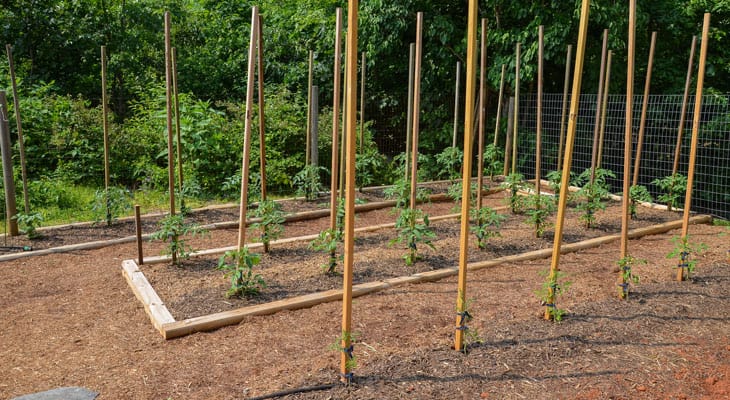
Today we will see several types of stakes for tomatoes and other crops. The technique of staking plants is not necessary for all crops in the garden, but it is important for those that reach a certain size, such as tomato plants, or pepper, cucumber, bean or aubergine plants.
The tutorado or tutorado is one of one of the main tasks of cultivation to take care of the plants of the orchard. Browse the post to discover the advantages of trellises and the types of trellises for tomatoes, to trellis peppers or for fruit trees.
✍ What is trellis and what plants need trellises?
Crop trellising is a technique that consists of placing guides in a more or less vertical position so that the stems of the plants follow that direction of growth. The stems support part of their weight on the stakes, thus preventing them from breaking due to the weight of the branches and fruits.
The guides or guardians can be made of different materials and can be attached/nailed to the ground or hanging from some structure placed in the upper part of the crops.
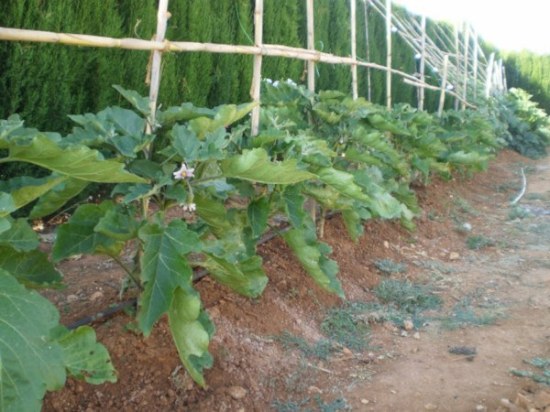
Staking is not necessary for low-growing plants such as leafy vegetables (cabbage, lettuce, spinach, Swiss chard…), nor is it necessary for bulbs, roots and tubers such as onions, garlic, leeks, carrots or potatoes.
We can even do without plant trellising in a few varieties of low-growing tomatoes and peppers … Although the truth is that in most fruit vegetables trellising will be necessary if we do not want the stems to bend and be compromised. Harvest.
The stakes for peppers, tomatoes or aubergines and the stakes for legumes and cucurbits such as beans, broad beans, cucumbers or pumpkins differ slightly.
The difference is that stakes for tomatoes, peppers, and other nightshades will need to be attached to the plant stems using a tying system with string, thread, or other material used to «hug» the plant stem together with the stake (It is important to leave it loose, that the stake and the plant are not too close together).
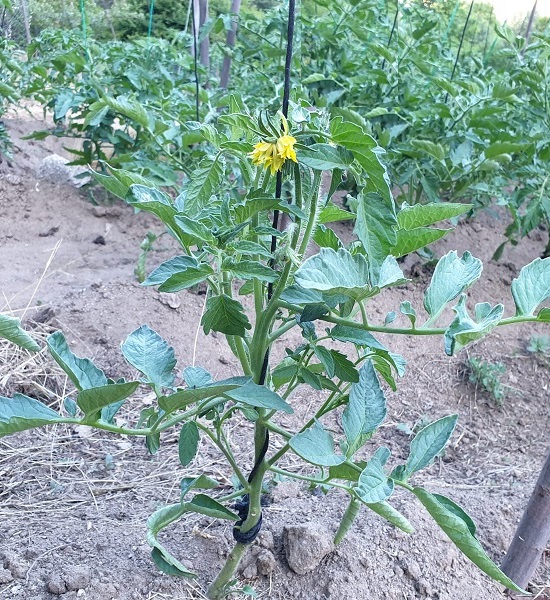
If we are going to use flexible supports such as plastic tapes or ropes to support tomatoes or peppers, we must wrap them around the stem in a spiral as the plant grows.
On the contrary, in the case of legumes such as beans or cucurbits such as cucumbers or pumpkins, this will not be necessary since they are climbing plants. Thanks to their tendrils, the plants will curl around the stakes without the need for us to hold them.
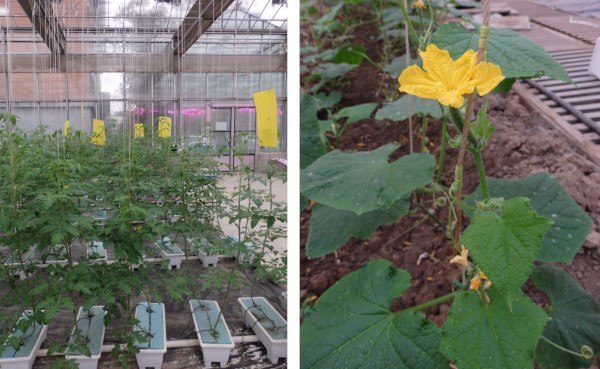
Detail of trellis for cucumber with tendrils twisted in the rope (right)
Other plants that need tutors are fruit trees during their first years of development. Trussing fruit trees will help guide their growth vertically and prevent strong winds or ground drift from causing trees to grow lopsided.
✅ Advantages of staking tomatoes
- The stakes prevent the plant from blowing over in the wind or storms.
- The tomato plant support supports the weight of the plant throughout the crop and prevents them from bending or snapping due to the weight of the branches or fruits due to the weakness of the stems.
- It favors aeration between the leaves and branches, thus reducing the risk of fungi appearing on the plants in the orchard.
- The plant is more widespread, so the sun’s rays reach all the leaves better and this translates into a better and faster development of flowers and fruits that favors an earlier harvest.
- The cultivation tasks that must be carried out to care for the plants in the orchard are facilitated, making it more comfortable to pass between the plants for phytosanitary treatments, pruning or harvesting.
▷ How to support garden plants: Types of supports for tomatoes
Below we will see several ways to trellise tomatoes, peppers and other garden plants.
Various types of stakes can be used to support plants: rigid or flexible. Among the rigid ones, wooden sticks or rods, bamboo canes, corrugated steel bars, etc. stand out. As flexible stakes we can use plastic or raffia rope, wire or even recycled plastic bags (see article Recycled materials for the garden).
1. Simple stakes or stakes
It is perhaps the easiest way to tutor. A rigid vertical stake is used for each plant. The stake must be driven into the ground deep enough to remain stable.
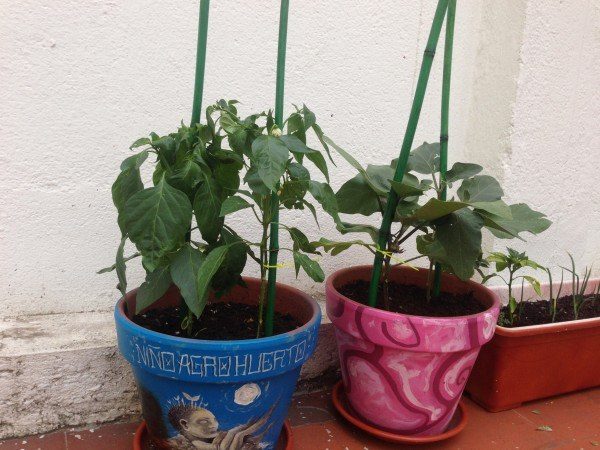
This is one of the most common systems for trellising potted plants.
2. Simple tutoring with ropes or ribbons
With this type of trellis, one trellis per plant is also used. In this case, the stakes are flexible (fabric or plastic tapes, ropes…) that must be attached to some upper structure and fall downwards to be tied to the base of the plant stem.

In the case of the tomato trellis that can be seen in the photo, the base structure has first been assembled with the help of several stakes or sticks with a «V» end (which are driven into the ground) on which they are supported. horizontal supports. Ropes or threads (one per plant) are attached to this horizontal structure of sticks parallel to the crop lines, which will then be attached to the base of the stem.
3. Mesh trellis or trellis
Trellis trellises are normally done with plastic strips, string or wire, but can also be done with small-diameter rigid poles. The tutors are arranged in the form of a grid (some horizontally and others vertically).

With this type of trellis, it is intended that the branches that carry the fruits rest on the horizontal guides, unloading the weight on the mesh. If you do not want to make a homemade trellis, you can buy ready-made trellis meshes (it is important to buy or manufacture a support structure -like the one seen in the photo- to hold the mesh)
4. Pyramid trellis (tipi or Indian tent-shaped tutors)
To make a pyramid -shaped tomato trellis, three or four canes or sticks are placed in the ground (at a height of 1.2-1.8 meters, depending on the size that the plant will reach) and they are joined at the top with esparto grass or raffia.

This system is very well suited to pruning tomato plants that leaves only one stem or guide per plant. The plants support or tie each one to a cane or stake and, when they grow, they cover the space between them forming a kind of cone like the ones seen in the photo above.

To support green beans, broad beans, peas and other climbers, you can also put horizontal supports or guides (of rope or plastic or rigid supports) that embrace the main supports so that the branches are also hooked in that direction.
5. Tutored in chapel or on easel
This trellising consists of placing a series of sticks or canes nailed to the lines of the tomato plants. The rods of two consecutive lines of plants are joined at the top (each one with the corresponding one of the opposite row) tilting them towards the center of the furrow that remains between them.

One or several rows of horizontal canes (with a separation of about 50 cm centimeters) are placed on these canes, which are tied to the vertical canes.
I hope this post is useful. These are just some ways of staking tomatoes, do you know others? If so, you can tell us about other types of tutors in the comment thread below.
References
- Serrano Cermeño, Z., 1973. Tomato Pruning and Staking. Disclosure Sheets of the Ministry of Agriculture of Spain.
- Salas, MC, 2002. Planting densities, pruning and trellising in protected tomato cultivation. International Horticulture, No. Extra 2002 (Report on the Horticultural Industry), p. 98-109.
- MARM, 2008. Specific tasks for tomato cultivation. Knowledge platform for the rural and fishing environment of the Ministry of the Environment and Rural and Marine Affairs, Spain.
- Roselló I Oltra, J. & Porcuna, JL, 2012. Ecological cultivation of tomato and pepper. SEAE Technical Notebooks. Series: Ecological Plant Protection.


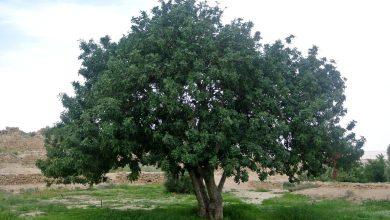

![Photo of Almond Pests and Diseases: [List and How to Fight Them]](https://www.complete-gardening.com/wp-content/uploads/2022/08/almond-pests-and-diseases-list-and-how-to-fight-them-390x220.png)